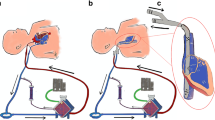Abstract
Newborns who require mechanical ventilation represent a high-risk population who have significant morbidity and mortality. Experienced handling of conventional therapies including high frequency oscillation ventilation and initiation of newer treatment options, such as surfactants and nitric oxide, has led to some improvements. Nevertheless extracorporeal membrane oxygenation (ECMO) is a life-saving technology in newborns with respiratory failure refractory to maximal medical therapy. This article demonstrates clinical management and selection criteria for ECMO in newborns contributing to the incidence and clinical signs of acquired diseases which may lead to so called neonatal acute respiratory distress syndrome (neonatal ARDS).
Zusammenfassung
Neugeborene, die künstlich beatmet werden müssen, stellen eine Risikogruppe mit hoher Morbidität und Mortalität dar. Schonendere konventionelle Beatmung sowie die Hochfrequenzoszillations-Ventilation und die Einführung neuerer Behandlungsverfahren wie die Therapie mit Surfactant oder Stickstoffmonoxid hat einige Verbesserungen erbracht. Dennoch ist die Extrakorporale Membranoxygenierung (ECMO) eine lebensrettende Technologie für diejenigen Neugeborenen mit Lungenversagen, bei denen die maximale klinische Therapie nicht greift. Dieser Artikel zeigt das therapeutische Management und die Auswahlkriterien für ECMO beim Neugeborenen ausgehend von den klinischen Zeichen der erworbenen Krankheiten, die zu einem so genannten akuten Atemnotsyndrom (neonatales ARDS) führen können.
Similar content being viewed by others
Literatur
Angus DC, Linde-Zwirble WT, Clermont G, Griffin MF, Clark RH (2001) Epidemiology of neonatal respiratory failure in the United States: projections from California and New York. Am J Respir Crit Care Med 164(7):1154–1160
The Neonatal Inhaled Nitric Oxide Study Group (2000) Inhaled nitric oxide in term and near-term infants: neurodevelopmental follow-up of the neonatal inhaled nitric oxide study group (NINOS). J Pediatr 136(5):611–617
Lotze A, Mitchell BR, Bulas DI, Zola EM, Shalwitz RA, Gunkel JH (1998) Multicenter study of surfactant (beractant) use in the treatment of term infants with severe respiratory failure. Survanta in Term Infants Study Group. J Pediatr 132(1):40–47
UK Collaborative ECMO Trial Group (1998) The collaborative UK ECMO (extracorporealmembrane oxygenation) trial: follow-up to 1 year of age. Pediatrics 101(4):E1
Clark RH (2005) The epidemiology of respiratory failure in neonates born at an estimated gestational age of 34 weeks or more. J Perinatol 25:251–257
Roy BJ, Rycus P, Conrad SA, Clark RH (2000) The changing demographics of neonatal extracorporeal membrane oxygenation patients reported to the Extracorporeal Life Support Organization (ELSO) Registry. Pediatrics 106(6):1334–1338
Piper JM (2002) Lung maturation in diabetes in pregnancy: if and when to test. Semin Perinatol 26(3):206–209
Gelfand SL, Fanaroff JM, Walsh MC (2004) Controversies in the treatment of meconium aspiration syndrome. Clin Perinatol 31:445–452
De Beaufort AJ, Bakker AC, van Tol MJD, et al (2003) Meconium is a source of pro-inflammatory substances and can induce cytokine production in cultured A-549 epithelial cells. Pediatr Res 54:491–495
Castelheim A, Lindenskov PH, Pharo A, et al (2004) Meconium is a potent activator of complement in human serum and in piglets. Pediatr Res 55:310–318
Schrama AJ, de Beaufort AJ, Sukul et al (2001) Phospholipase A2 is present in meconium and inhibits the activity of pulmonary surfactant: an in vitro study. Acta Paediatr 90:412–416
Velaphi S, Vidyasagar D (2006) Intrapartum and postdelivery management of infants born to mothers with meconium-stained amniotic fluid: evidence-based recommendations. Clin Perinatol 33(1):29–42
Vain NE, Szyld EG, Prudent LM, Wiswell TE, Aguilar AM, Vivas NI (2004) Oropharyngeal and nasopharyngeal suctioning of meconium-stained neonates before delivery of their shoulders: multicentre, randomised controlled trial. Lancet 364(9434):597–602
Wisswell TE, Knight GR, Finer NN (2002) A multicenter, randomized controlled trial comparing Surfaxin (lucinactant) lavage with standard care for meconium aspiration syndrome. Pediatrics 109:1081–1087
Hintz SR, Suttner DM, Sheehan AM, Rhine WD, Van Meurs KP (2000) Decreased use of neonatal extracorporeal membrane oxygenation (ECMO): how new treatment modalities have affected ECMO utilization. Pediatrics 106(6):1339–1343
Petrucci N, Iacovelli W (2007) Lung protective ventilation strategy for the acute respiratory distress syndrome. Cochrane Database Syst Rev 18(3):CD003844
Cheung PY, Barrington KJ (2001) The effects of dopamine and epinephrine on hemodynamics and oxygen metabolism in hypoxic anesthetized piglets. Critical Care 5:158–166
Bahrami KR, van Meurs KP (2005) ECMO for neonatal respiratory failure. Semin Perinatol 29(1):15–23
Schrag SJ, Zywicki S, Farley MM, Reingold AL, Harrison LH, Lefkowitz LB, Hadler JL, Danila R, Cieslak PR, Schuchat A (2000) Group B streptococcal disease in the era of intrapartum antibiotic prophylaxis. N Engl J Med 342(1):15–20
Möller J (2002) Surfactanttherapie des respiratorischen Versagens bei Kindern und Erwachsenen, 1. Aufl. Uni-Med, Bremen
Herting E, Gefeller O, Land M, van Sonderen L, Harms K, Robertson B (2000) Surfactant treatment of neonates with respiratory failure and group B streptococcal infection. Members of the Collaborative European Multicenter Study Group. Pediatrics 106(5):957–964; discussion 1135
Avery ME, Gatewood OB, Brumley G (1966) Transient tachypnea of newborn. Possible delayed resorption of fluid at birth. Ann J Dis Child 111:380–385
Morrison JJ, Rennie JM, Milton PJ (1995) Neonatal respiratory morbidity and mode of delivery at term: influence of timing of elective caesarean section. Br J Obstet Gynaecol 102:101–106
Kossel H, Bauer K, Kewitz G, Karaca S, Versmold H (2000) Do we need new indications for ECMO in neonates pretreated with high-frequency ventilation and/or inhaled nitric oxide? Intensive Care Med 26(109:1489–1495
Kachel W, Schaible T (2004) ECMO beim Neugeborenen. In: Rieger C, Hardt Hvd, Sennhauser SH, Wahn U, Zach M (Hrsg) Pädiatrische Pneumologie, 2. Auf. Springer, Berlin Heidelberg New York
McNally H, Bennett CC, Elbourne D, Field DJ, UK Collaborative ECMO Trial Group (2006) United Kingdom collaborative randomized trial of neonatal extracorporeal membrane oxygenation: follow-up to age 7 years. Pediatrics 117(5):e845–854, Epub 2006 Apr 24
Conrad SA, Rycus PT, Dalton H (2004) Extracorporeal Life Support Registry Report. ASAIO Journal 2005:4–10
Author information
Authors and Affiliations
Corresponding author
Additional information
Serie: Respiratorisches Versagen im Früh- und Neugeborenenalter Herausgegeben von L. Gortner (Homburg/Saar)
Rights and permissions
About this article
Cite this article
Schaible, T. Erworbene Atemstörungen beim reifen Neugeborenen: Diagnostik und Therapie einschließlich extrakorporaler Membranoxygenierung. Intensivmed 45, 111–120 (2008). https://doi.org/10.1007/s00390-008-0867-1
Received:
Accepted:
Published:
Issue Date:
DOI: https://doi.org/10.1007/s00390-008-0867-1




